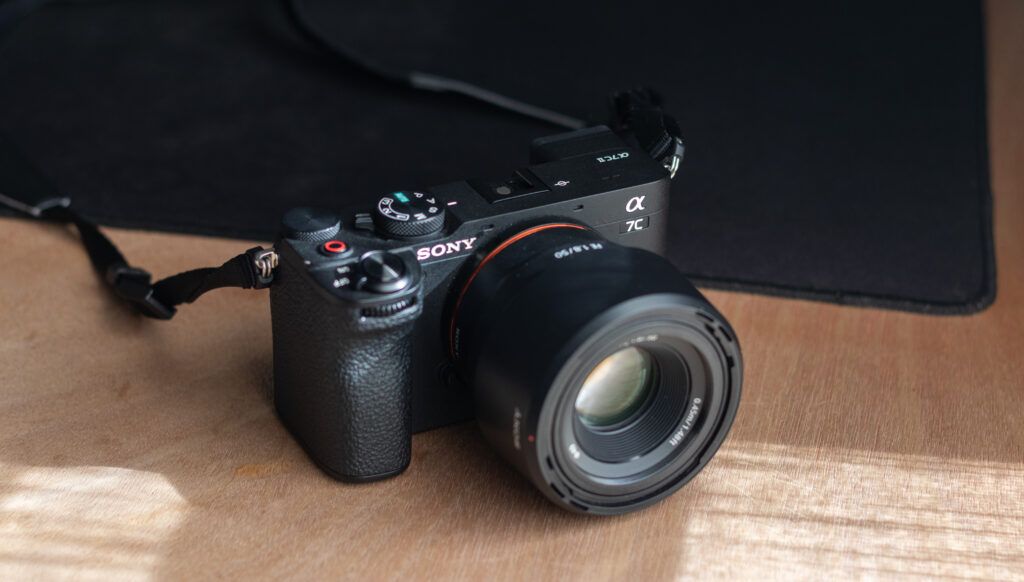Introduction
The Sony A7C is a super interesting model, as it arrived almost 4 years ago with a proposal based on offering a full-frame experience with an extremely compact body and design. coming closer to the compact range of the Japanese firm (the a6000) than to the conventional A7.
This proposal was only renewed almost at the end of last year, where we saw the arrival of its second generation, the A7C II, which was also accompanied by a model designed for more “pro” users, who seek higher resolution in their photos: the A7C R.
However, the model that summons us today is the first: the A7C II. With renewed features and an interesting format, Will this be the best entry-level option with a full-frame sensor on the market? Let’s see it in the following review:
Design and ergonomics
The Sony a7C is the compact model of the brand’s full-frame camera family, which to be honest doesn’t say much, because these Sony devices have almost always been more compact than their Canon and Nikon counterparts.
This camera adopts a rangefinder type format, where the visor is on the side of the chassis, which allows the effective height of the equipment to be reduced. For reference, the rest of the models in the a7 range (and the vast majority of full-size sensor cameras) use the typical SLR-type design, with the viewfinder raised in the center of the body.
Its dimensions are 124.0 x 71.1 x 63.4 mm, and its mass is 514 grams with the battery and memory card included. The chassis is mainly constructed of a magnesium alloy, although it is accompanied by a couple of plastic parts. Nothing terrible in my opinion, considering the type of camera and price it has.
In terms of ergonomics, this a7C II complies adequately. The grip is good, but nothing outstanding, especially for those of us who have large hands, which can often leave our little finger in the air due to not having enough space when holding the camera.
The buttons and dials are very well located, but you miss a joystick or something to select the focus and to navigate the menus. The touch screen is not very comfortable for this task, since many times it happened to me that it tends to generate false/involuntary touches, changing the focus point at the last moment.
Let’s now see what this camera brings:
On the back we have the 3-inch (articulated) LCD touch screen and a resolution of 1.04 million dots. This is accompanied by the electronic viewfinder (EVF) on the left side of the chassis, which is a 0.39-inch OLED panel with 2.36 million dots and a 120Hz refresh rate.
Of course we also find all the buttons to navigate the menus and configure the parameters. Two dials stand out here — one on the top and another that comes with directional buttons.
On the front we have the E lens mount along with the button that allows them to be removed from the camera, and on the grip, another dial to adjust the camera parameters. Then, on the lower side of the camera we have the slot for the battery and the mount (thread) to mount a tripod.
At the top we have the hot shoe to put a flash, the shutter, a button to record video, the wheel to rotate between the photography modes, and two switches: one to turn the camera on/off; and another to switch between photos, videos and a mode to record timelapses and slow motion videos.
Finally, on the left side we have the different ports that the camera has, such as a mini-HDMI, a 3.5mm jack, a USB-C, and a single slot for SD cards (UHS-II).
Image and video quality
The Sony A7C II arrives with important improvements over its predecessor, although they are not particularly new specifications. The 33 megapixel Exmor R CMOS sensor and the Bionz XR processor that this camera has come from the A7 IV, a model presented at the end of 2021. What is new, It is a processing unit based on artificial intelligence which supports different camera systems.
It also comes with an in-body stabilization system (IBIS) of up to 7 steps, 759 autofocus points, the ability to record up to 4K at 60 frames per secondan ISO range that goes from 100 to 51,200 (and is expandable to ISO 50-204,800).

Our test unit came with a 50mm f/1.8 lens (model SEL50F18F), so the vast majority of photos were captured with that lens, although we also briefly tested it with a Sigma 50mm f/1.4 Art.
Also, all the images were captured in JPEG and RAW at the same time, but all the ones you will see here will be the compressed files straight from the camera, without any editing.
Photographs
As one usually expects from this type of camera — and particularly from Sony — the quality of the photos delivered by this a7C II They are excellent.
Starting with the colors, here we can highlight the good balance between saturation and the intensity of the tones that are captured. This translates into photos with vivid and “pretty” colorsbut without looking excessively processed (saturated) — that is, they follow a slightly more realistic line.
By default, warm tones tend to predominate more in photos, but this can obviously be adjusted with the white balance; and there are also a number of picture profiles that allow you to change these settings quickly.
The second part of this equation is on the detail and sharpness side of the photos.
The 33 MP sensor is a very good middle ground between image quality and performance. For the vast majority of people, this is more than enough resolution to capture a lot of detail without having to suffer the pains of having a very high-resolution sensor — such as increased noise or excessive final file sizes.
Dynamic range is very good. In almost all cases he manages to correctly expose a shot; while the stabilization system helps to take good photos even when the light is low. And while we’re talking about that, even if we don’t have a very bright lens, the photos should come out with very little noise despite using a relatively high ISO.
The autofocus system is excellent. Do you remember that processor with AI? The main beneficiary of this was the autofocus, which together with its 759 focus points, we obtain a super fast and reliable system, including the recognition of subjects or objects. At night it costs a little more, but it’s still pretty good.
Video
Regarding this section, the Sony A7C II is capable of recording in 4K at 30 frames per second, or in 4K at 60 frames per second, but with a fairly considerable crop to the sensor (approximately 1.5x). In Full HD, this camera can record up to 120 frames per second, which is for slow motion mode.
Color management is an interesting topic. In 4K 30p mode can record 10-bit video, which simply means that it is capable of capturing much more color than its predecessor (which recorded in 8-bit). Now, in practice it is not something that is necessarily noticeable to the naked eye, unless you are dedicated to video editing.

Likewise, we have a good variety of configurations, including the possibility of selecting different LUTs (color profiles)and the possibility of recording in S-log3, which makes the process of color and exposure adjustments in post-production more flexible.
The videos in general are good, beyond the fact that we have a cutout to the sensor when we record at resolution and framerate Maximum, there is not much to reproach him for. Video looks great in all available resolutionswith a very good level of definition even in very low light situations — although in this case it also depends a lot on the lens we are using.
The audio coming from the camera’s microphone is somewhat short, in fact you may notice that the volume is heard super low, and the wind quickly affects the quality, so it is best to use an external microphone. On the stabilization side there are no complaints, thanks to the stabilization system that comes in the body we obtain videos with very little movement and hustle.
The videos below were recorded in S-log3 (which is why the colors look slightly dull), and later reprocessed in Da Vinci Resolve applying Sony’s Rec.709 LUT:
In simple, This camera meets the basics for video. For the hobbyist it is more than enough, but for someone who wants something more powerful in this regard, there are other models in the Alpha family for these tasks (both inside and outside the a7).
Software and performance
In the software field we have news. This a7C II incorporates a slight facelift in the interface that it uses, which is very good news, because it has not always been very good.
Everything is slightly more simplified, and is more oriented so that it can be used by touching the screen. There are more colors and graphics that tell you what type of menu or setting you are in. In short, it is a much more pleasant user experienceand above all, much less frustrating than before.
The LCD touch screen looks good, and the brightness level is adequate, although I think the resolution is a little poor. This is compensated by the electronic viewfinder, which with its OLED panel, higher resolution and refresh rate compared to the external screen, provides an excellent viewing experience.
As I mentioned before, my only complaint — which may well be my problem — is on the side of the involuntary touches one can do. I’m struck by how many times this happened to me when I wanted to use the viewfinder, and I don’t know whether to attribute it to the way I hold the camera or the sensor that disables the touch screen when you get close.
Performance is good, both in terms of movement within the interface and the capabilities of the camera in general. Autofocus is fast — we already talked about that — and this camera is capable of taking up to 10 photos per second, which is the standard within this segment.
To close, let’s talk about the autonomy of this camera.
sony ensures about 530 to 560 shots, or between 100 to 105 minutes of video recording, which in my brief experience agrees with what was promised. This duration is more than fine, and the other good thing is that it is not necessary to use an external battery charger for this task, since it can be charged using a USB-C cable connected directly to the camera.
Conclusions
The second generation Sony A7C has very good credentials to position itself as one of the best entry-level full frame cameras.
The combination of the hardware with the different functionalities it offers, plus its compact size, make it a great camera for travel or for taking more casual photos, landscapes, portraits, etc. In practically all points it satisfactorily compliesand has no real weaknesses.

It is a very versatile camera, although be careful, as long as we stay in the most amateur field of photography. Because if you are looking for something more “pro”, you will probably fall a little short. Things like the lack of a second slot for SD cards or the fact that the ergonomics are not necessarily the best can work against you for photos at weddings or at sporting events.
Having said that, it’s worth it? Absolutely. If you are looking to make the jump from a camera with an APS-C sensor to a full-frame one, and you do not do “professional” photography work, it is an absolute yes. It is a very good value for money proposition, especially if you are coming from other Sony models that use the E mount.
Now, if you already have a previous generation a7C, or another model in the a7 family that is relatively recent, it is most likely not worth upgrading to this model, because there are not that many improvements that it brings — especially considering that It is very similar in specifications to the a7 IV from three years ago.
Availability
The Sony a7C II is available for purchase in our country through the company’s website. Its price is CLP $2,319,989 (body only), and is available in black and gray colors.











